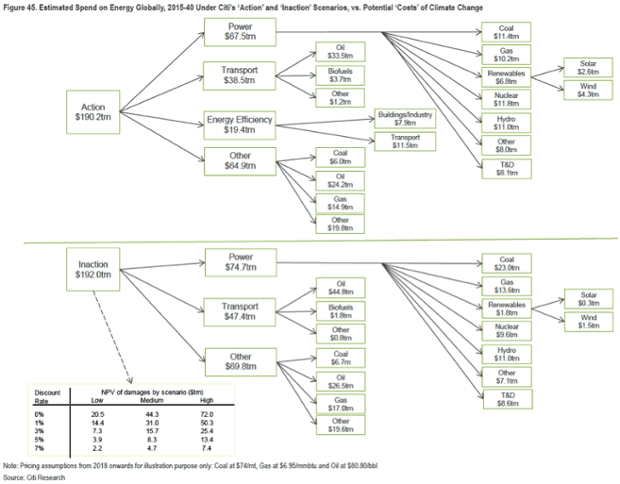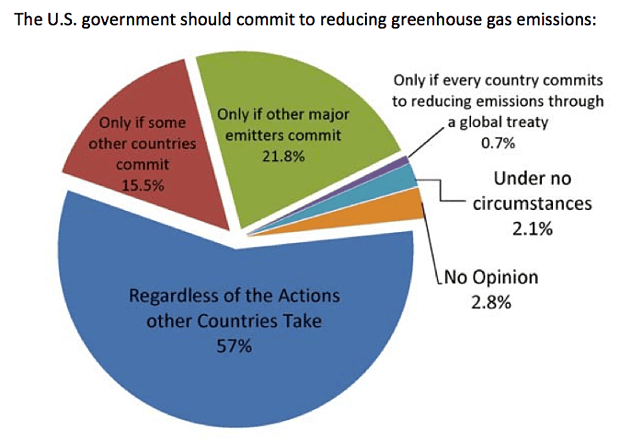
Citi Global Perspectives & Solutions (GPS), a division within Citibank (America’s third-largest bank), recently published a report looking at the economic costs and benefits of a low-carbon future. The report considered two scenarios: “Inaction,” which involves continuing on a business-as-usual path, and Action scenario which involves transitioning to a low-carbon energy mix.
One of the most interesting findings in the report is that the investment costs for the two scenarios are almost identical. In fact, because of savings due to reduced fuel costs and increased energy efficiency, the Action scenario is actually a bit cheaper than the Inaction scenario.
What is perhaps most surprising is that looking at the potential total spend on energy over the next quarter century, on an undiscounted basis the cost of following a low carbon route at $190.2 trillion is actually cheaper than our ‘Inaction’ scenario at $192 trillion. This, as we examine in this chapter, is due to the rapidly falling costs of renewables, which combined with lower fuel usage from energy efficiency investments actually result in significantly lower long term fuel bill. Yes, we have to invest more in the early years, but we potentially save later, not to mention the liabilities of climate change that we potentially avoid.
The following figure from the Citi report breaks down the investment costs in the Action ($190.2 trillion) and Inaction ($192 trillion) scenarios.

Investment costs of climate Action and Inaction scenarios. Source: Citi GPS.
This conclusion soundly refutes the main argument against climate action – that it’s too expensive, with some contrarians even having gone so far as to claim that cutting carbon pollution will create an economic catastrophe. To the contrary, the Citi report finds that these investments will save money, before even accounting for the tremendous savings from avoiding climate damage costs.
What about those avoided climate costs? As shown in the bottom left corner of the above figure, the difference in climate damage costs between low (1.5°C) warming and high (4.5°C) warming scenarios could be as high as $50 trillion. Even moderate (2.5°C) warming could cost $30 trillion less than a business-as-usual high global warming scenario.
As a result, the Citi report concludes that taking action to cut carbon pollution and slow global warming would result in a positive return on investment.
By comparing the cost of mitigation to the avoided ‘liabilities’ of climate change, we can derive a simple ‘return on investment’. On a risk adjusted basis this implies a return of 1-4% at the low point in 2021, rising to between 3% and 10% by 2035.
This isn’t a groundbreaking finding. Other reports have arrived at the same conclusion, and have found that a revenue-neutral carbon tax would be modestly beneficial for the economy (again, before accounting for the economic benefits of curbing global warming). This is why there’s a consensus among economists that we should be reducing carbon pollution.

Survey results of economists with climate expertise when asked under what circumstances the USA should reduce its carbon emissions. Source: New York University; Economists and Climate Change report.
The Citi report then asks the trillion-dollar question – if tackling global warming is such an economic no-brainer, what are we waiting for?
With a limited differential in the total bill of Action vs Inaction (in fact a saving on an undiscounted basis), potentially enormous liabilities avoided and the simple fact that cleaner air must be preferable to pollution, a very strong “Why would you not?” argument regarding action on climate change begins to form … Coupled with the fact the total spend is similar under both action and inaction, yet the potential liabilities of inaction are enormous, it is hard to argue against a path of action.
Dave Roberts at Vox took a stab at answering that question, and the answer is touched upon in the Citi report:
The clear loser between the scenarios is coal, which sees its total investment bill fall by some $11.5 trillion over the next quarter century. Gas investment also reduces though by a far smaller amount, $3.4 trillion in total
While the global economy would clearly benefit from climate action, it would create “stranded assets” for the fossil fuel industry, because a large percentage of known fossil fuel reserves must be kept in the ground if we’re to avoid dangerous climate change.
Some studies suggest that globally a third of oil reserves, half of gas reserves and over 80% of current coal reserves would have to remain unused from 2010 to 2050 in order to have a chance of meeting the 2°C target.
Posted by dana1981 on Monday, 31 August, 2015
 |
The Skeptical Science website by Skeptical Science is licensed under a Creative Commons Attribution 3.0 Unported License. |